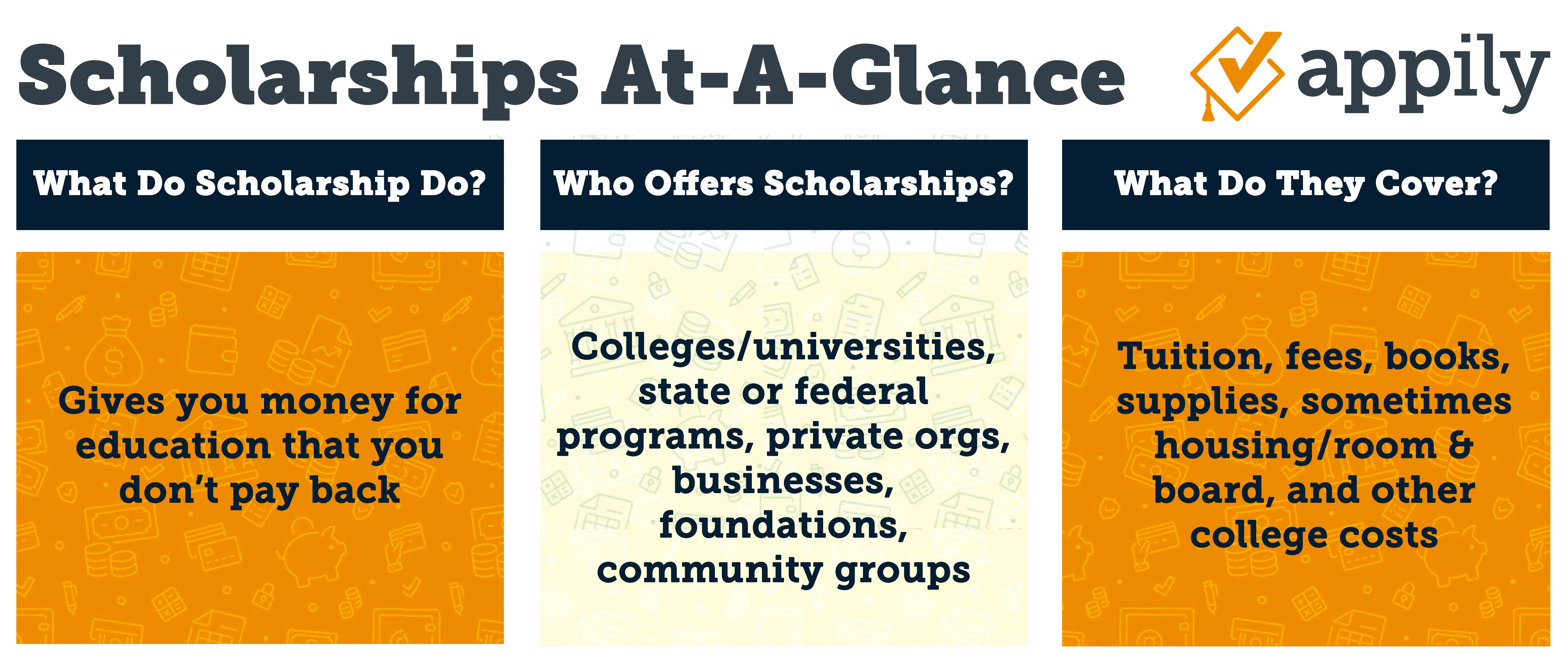What is a Scholarship & How Do Scholarships Work?

College can be expensive. Thankfully, scholarships exist to lighten that load, often significantly. Whether you’re a high school student planning ahead or someone already applying, knowing what scholarships are, how they work, and how to get one can make all the difference.
Here’s everything you need to know about scholarships: what they are, who qualifies, how to apply, and smart tips to improve your chances.
Find free money for college
Our up-to-date scholarship database is one of the nation’s largest. Find money to help you fund your education.
What are scholarships?
A scholarship is a form of free money for college. In other words, financial aid for an undergraduate or graduate degree that does not need to be repaid. So, to answer a question we often hear, you do not have to pay it back if you get a scholarship. Sometimes a scholarship comes in a one-time check. Other scholarships are renewable and provide students with money each semester or school year.
Scholarships are offered by colleges, governments, nonprofits, companies, and even individuals. Many scholarships are based on academic merit, financial need, special talents or circumstances–or a mix of these. They may cover tuition, fees, books, housing, or other education-related costs. If the scholarships and other forms of financial aid are enough to cover the direct college costs, the excess money is refunded to the student.

Where do scholarships come from?
Scholarships come from various sources, including clubs, organizations, charities, foundations, businesses, colleges and universities, the government, and individuals. These scholarships can be merit-based, need-based, or a combination of both, giving you opportunities to continue your education without taking on a significant financial burden.
Merit-based scholarships
Merit-based scholarships are granted based on your academic or extracurricular achievements, including high grades, test scores, athletic or artistic accomplishments, or community service. These scholarships reward and encourage excellence and usually require students to meet specific eligibility criteria to be considered.
Need-based scholarships
Need-based scholarships are awarded according to your financial need. Therefore, factors such as your family income, assets, and other circumstances that may impact your ability to pay for college are factored into the eligibility decision.
Eligibility for need-based scholarships is typically determined after you complete the Free Application for Federal Student Aid (FAFSA) or other financial aid applications like the CSS Profile. Need-based scholarships can help cover tuition, fees, room and board, and other college expenses for students who may not have the financial means to pay for college independently.
Scholarships that are both merit-based and need-based
In some instances, scholarships may encompass merit-based and need-based components, considering your academic achievements and financial needs. Therefore, it is crucial to research the specific eligibility criteria for any scholarship you're interested in so you'll know if you're eligible to apply.
What are the main sources of scholarships and grants?
There are four major types of free money available to college applicants. We will list and discuss them below with the percentage of total grants and/or scholarships that come from each source:
| Source | Percent of Total Grant/Scholarship Aid |
|---|---|
| Federal grants | 47% of all financial aid |
| State grants and scholarships | 8% of all financial aid |
| Scholarships and grants from schools | 35% of all financial aid |
| Private Scholarships | 10% of all financial aid |
Here’s a deep dive on each:
Federal Aid (about 47% of all aid)
It's estimated that the federal government gives out $120 billion each year in federal aid. But if you are looking for merit scholarships from the federal government, you will be out of luck. Almost all grants from the federal government require demonstrating financial need. You must complete the Free Application for Federal Student Aid (FAFSA) to qualify for any federal grants.
Expert tip: Complete the FAFSA, even if you don't think you'll qualify for aid. Each year, money goes unawarded simply because students fail to complete the application.
According to the National College Attainment Network (NCAN), in 2024 alone, over $4 billion of grant money went unused by those who did not complete the FAFSA. Fortunately, that process has been made easier by the new and improved Better FAFSA, which you can read about by clicking the link.
Types of Federal Student Aid
- Pell Grant
By far, the Pell Grant is the biggest federal grant. Pell Grants are available to students with demonstrated financial need. For context, during the award year 2024-2025, 78 percent of Pell Grant recipients had a family income of less than $40,000 a year.
The current full grant, which is adjusted annually, is $7,395 for the 2025-2026 award year.
Is FAFSA a Pell Grant?
Answer: No. The FAFSA is the application, and a Pell Grant is one type of financial aid available to students who complete the FAFSA.
- Federal Supplemental Educational Opportunity Grant
The FSEOG is available for students who have "exceptional financial need." If you don't qualify for a Pell Grant, you won't be eligible for this grant that ranges from $1,000 to $4,000 annually. The FSEOG will not be available on all campuses, and the money can run out.
- Education Tax Benefits
The federal government provides several education tax benefits, which are claimed on your federal income tax return. Some are based on tuition and textbook costs. These include the American Opportunity Tax Credit (AOTC), Lifetime Learning Tax Credit (LLTC), and Tuition & Fees Deduction.
Of these, the AOTC yields the most significant tax savings per dollar of qualified higher education expenses, but it is limited to four years. As a result, the LLTC is used mainly by graduate and professional students and continuing education students after they exhaust eligibility for the AOTC.
Another popular education tax benefit is the Student Loan Interest Deduction, which provides an above-the-line exclusion from income for up to $2,500 in interest paid on federal and private student loans.
- Veterans and Military Student Aid
The federal government provides several types of military student aid to members of the U.S. Armed Forces and veterans. These include ROTC Scholarships, the Montgomery G.I. Bill, the Post-9/11 G.I. Bill, the Yellow Ribbon Program, U.S. Armed Forces Tuition Assistance (TA), and the Student Loan Repayment Program.
- Federal Loans
You can turn to federal loans if you aren't eligible for federal grants.
The Direct Loan is for those who file the FAFSA and attend school at least half the time. During five years, students can borrow a maximum of $31,000.
The PLUS Loan is designed for parents of undergraduate students and graduate and professional students. Parents can borrow the difference between the cost of the school and what their child received in financial aid.
State aid (about 8% of all aid)
Almost every state education agency has at least one grant or scholarship program available to state residents. Some offer several programs.
States in the South are more likely to award money based on grade point average and possibly test scores. States on the East and West coasts are more likely to provide awards based on financial need.
An easy way to learn more about aid programs in your state is to head to the website of the National Association of Student Financial Aid Administrators (NASFAA).
On the NASFAA website, you can find links to your state aid programs by following these steps:
- Click on the Students, Parents & Counselors link
- Then click on the Financial Aid in Your State link
- Next, choose the State Financial Aid Programs link
- Once you call up the U.S. map, click on your state
Some state programs, such as those in California and New York, have centralized systems, meaning state-level formulas set awards. In other states, the government sets essential criteria, but it allows public universities to exercise some discretion when making the awards. States in this category include Texas and Virginia.
Institutional (school) grants and scholarships (about 35% of all aid)
Here is how the award process often works. A student applies to a school, and the admission office decides whether to accept the applicant. If the school gives merit scholarships, the decision typically will be made during the acceptance process, usually based on the student's grades and test scores.
This often happens before the school knows if a student qualifies for need-based aid. Then, when the school reviews the financial aid form, the admission staff decides whether a child still needs assistance, even after considering merit scholarships.
If the school is willing to give additional assistance, it will award a need-based grant on top of the scholarship. Unfortunately, the most highly-ranked research universities and liberal arts schools offer no merit scholarships.
Their aid is exclusively in the form of need-based grants. Consequently, if you don't qualify for need-based aid, you will pay the total price at these institutions. Because of the wide variety of assistance you can encounter, it's essential to use a net price calculator when evaluating the generosity of any school.
Private scholarships and employer grants (about 10% of all aid)
Outside groups such as foundations, civic groups, companies, religious groups, professional organizations, and charities award private scholarships. Many people assume that private scholarships represent the most significant source of school money, but as you learned, they are among the smallest sources.
Unlike other sources, these scholarships typically last for just one year; most of these awards are under $4,000. As a result, the odds of winning a scholarship are about one in eight. Prestigious scholarships can have odds of one in 250 or one in 500.
Can I Get a Scholarship?
Yes! Many scholarships are designed for more than just “top of the class” students. Since there are many different types, you might qualify in several ways:
- Academic achievement (good grades, test scores)
- Financial need (low or moderate family income)
- Special talents, hobbies, background, or experiences
- Intended major or field (STEM, arts, education, etc.)
- Athletic or artistic skills
Because scholarships are so varied, it’s smart to cast a wide net. Apply to many, not just a couple. Even smaller awards add up and reduce how much you have to borrow.
The Pros and Realities of Scholarships
Why Scholarships Are Great
- They don’t need to be repaid (unlike student loans).
- They can significantly reduce or eliminate tuition costs and other education-related expenses.
- They often reward excellence, talent, or need, opening opportunities to a wide range of students.
What to Know
Scholarship competition can be stiff. Not everyone who applies will get one. According to a 2025 report, only about 11% of students receive scholarship awards nationally.
- Many awards are modest. While some scholarships are worth thousands, many provide smaller awards that may not cover full tuition.
- Scholarships may have conditions. Some require you to maintain a certain GPA, remain enrolled full-time, or meet other criteria.
- Not all scholarships cover living expenses. Some only cover tuition or books, and you may still need other financial aid for housing or daily costs.
Are you looking for scholarships?
Supplement the college and university scholarships you receive by checking out Appily's scholarship database. We have millions of dollars worth of scholarships you can apply for to help bring down the cost of college, and they've all been vetted, so they're legit and scam-free.
Click the button below to create a free account and get personalized scholarship matches today! You'll automatically be entered for the Appily $1,000 Easy Money Scholarship that's awarded each month.

Scholarship FAQs
How can scholarship money be spent?
Scholarship checks awarded in your name can be spent on anything, but you would be wise to look at this as an investment and not a free pass to splurge on video games or concert tickets. This money is for school expenses. This could mean tuition, but it could also be books, pencils, housing, food (you can't study on an empty stomach), or even computers and software.
When you receive the scholarship money depends on the scholarship you won. Sometimes you get the money in one chunk before school begins; in other cases, the money is distributed in installments. Sometimes a scholarship may be paid out in the middle of a semester.
How are scholarships awarded? Who can qualify for them?
Scholarships aren't awarded just to students with a 4.0 GPA. Each scholarship has its own criteria, as we mentioned above. For example, some scholarships are awarded based on need. For others, you must be a member of an organization, studying a specific field, an exceptional athlete, or fit whatever guidelines the group awarding the money decides upon.
Regardless of whether you excel in academics or sports, you should be able to find several scholarships that work for you. There are even scholarships intended for students living in a particular state or town. In addition, you can continue to apply for scholarships during your collegiate years up to your Ph.D. studies.
We encourage you to apply for as many scholarships as possible so you don't miss out on any free money.
Who can apply for scholarships?
Scholarships are available to high school students, current college students, and even adults returning to school. Each scholarship has its own set of eligibility requirements, so it's essential to research and read the guidelines carefully before applying.
When should I start applying for scholarships?
It's never too early to start researching and applying for scholarships. Many scholarships are available to high school students in their junior and senior years, but some are also open to younger students. It's a good idea to begin your search early and create a calendar to track application deadlines.
Where can I find scholarships?
Scholarships can be found through a variety of sources, including:
- Your high school guidance office
- College and university financial aid offices
- Online scholarship search engines, such as Fastweb, Scholarships.com, and Appily
- Community organizations, such as local clubs, foundations, and businesses
- Professional associations related to your field of study
How do I apply for scholarships?
Each scholarship has its own application process, including submitting an online or paper application, writing essays, providing letters of recommendation, or submitting transcripts and test scores. Be sure to carefully follow the application instructions and submit all required materials by the deadline.
What is the difference between need-based and merit-based scholarships?
Need-based scholarships are awarded based on a student's financial need, as determined by their family's income, assets, and other factors. Merit-based scholarships are awarded based on a student's academic, athletic, artistic, or other achievements, regardless of their financial situation.
Can I win multiple scholarships?
Yes, students can apply for and win multiple scholarships. However, it's important to note that some colleges and universities may reduce your financial aid package if you win a large enough scholarship. That's because a considerable scholarship can decrease your financial need, so the school may think you don't require as much aid.
Do I have to pay taxes on my scholarship?
Scholarships for tuition, fees, and required books or supplies are generally tax-free. However, if you use your scholarship funds for other expenses, such as room and board, travel, or optional equipment, those scholarship funds are usually taxable. Again, it's good to consult a tax professional or the IRS website for more information.
Can international students apply for scholarships?
Yes, many scholarships are available to international students studying in the United States. However, research scholarships are specifically for international students, as eligibility requirements may differ from those for U.S. citizens.
What should I do if I don't win a scholarship?
Don't get discouraged if you don't win a scholarship right away. Keep searching and applying for scholarships throughout your high school and college years. Additionally, you can explore other financial aid options, like grants, work-study programs, and even student loans, to help fund your education.